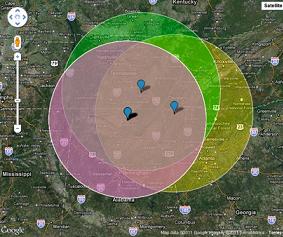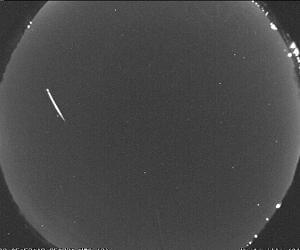
A major government agency is looking to blanket the US with cameras that will never stop their surveillance. But don’t worry privacy pundits, those cameras will be spying on the sky, not civilians. NASA’s All-sky Fireball Network is a series of cameras that track meteorites as they enter the atmosphere. With careful triangulation, NASA can not only know where the meteorites will land, they can determine where they came from as well. It’s not meant to be a warning system, but it could help scientists recover space rock, and it will definitely give us information to help build the next generation of spacecraft, which have to contend with damage from meteors. One of the coolest parts of the All-sky Fireball Network is that it’s fully automated. Meteors are detected by a computer which sends images, video clips, and data analysis to William Cooke, head of NASA’s Meteoroid Environment Office. Now you can get the same information as Cooke, too – the All-sky Fireball Network’s website publicly records all the data for you to peruse. Want to see the meteors from last night? Here they are. With only three cameras operational, the All-sky Fireball Network is still pretty small, but as it expands across the US it could serve as a great example of how automated video systems will transform our understanding of the world, and universe, around us.

Each of the All-sky Fireball Network’s cameras is a black and white video recorder that captures the entirety of the night sky around it. They don’t miss anything. With one camera in Huntsville, Alabama, another in Chickamauga, Georgia, and the last in Tullahoma Tennessee, the network can monitor a significant portion of the sky in that part of the US. With a large area of overlapping coverage, NASA can use variations in position, movement, and intensity between cameras to determine where a meteorite is coming from and where it is headed as well as its relative speed and size. Over the region it monitors, the All-sky Fireball Network is king. Nothing big gets by without being recorded. As William Cooke told NASA Science News:
“If someone calls me and asks ‘What was that?’ I’ll be able to tell them. We’ll have a record of every big meteoroid that enters the atmosphere over the certain parts of the U.S. Nothing will burn up in those skies without me knowing about it!”
Cooke plans on expanding the network considerably in the future. The first step is upgrading to 15 cameras across the eastern half of the US. NASA is actively soliciting schools, planetariums, and science centers to host the devices. If you’re a principal or curator interested in the project contact Cooke to learn more about participating.

From 15 cameras the All-sky Fireball network could expand to an even larger surveillance of the night sky. Cooke is focused on the US east of the Mississippi for now. There are other networks that cover parts of the (less densely populated) regions of the nation to the west. What sets the All-sky Fireball Network apart from these other systems, however, is that it’s fully automated. Other sky surveillance programs require humans to actively sift through the camera feeds as they spy on the stars. All-sky Fireball takes advantage of modern narrow AI programs that can identify objects in video footage, generate clips, and analyze results. We’ve seen commercial programs, like Vitamin D Video, that do the same for CCTV and web cameras. NASA’s All-sky Fireball Network uses ASGARD (All Sky and Guided Automatic Realtime Detection) which was developed at the University of Western Ontario with funding from NASA and Canada. ASGARD not only handles all the data processing (which is considerable) it also automatically pushes the results to the web. All Cooke has to do is read emails, and all you have to do is go to the website and browse. Spying on meteorites is easy!
Which brings up an interesting question: will this sky surveillance lead to more invasive/advanced forms of security surveillance? Perhaps, but not intentionally. ASGARD is a work in progress, and it continues to improve. Any new computer AI tracking techniques could probably be leveraged to be used in other video surveillance systems. Yet that’s clearly not how NASA is hoping to focus its efforts. The All-sky Fireball Network is really centered on meteorite tracking, and it’s primarily hoping to use information gathered to better understand the speed and size of objects that travel into Earth’s near orbit. If NASA can determine how often a spacecraft-damaging chunk of rock flies by, they can better design future spacecraft to survive. There’s also a good chance that they’ll recover many more meteorites that hit the ground. As one of Cooke’s assistants told NASA Science News:
“Most meteorites fall in the ocean, lakes, forests, farmer’s fields, or the Antarctic…and the majority of those meteorites will never be found. But our system will help us track down more of them.”
Not only will the system help us find these rocks, they’ll tell us their most likely origin. As Cooke puts it: “And when we collect the meteorite chunks, we’ll know their source. I could be holding a piece of Vesta in my hand. It would be like a free sample return mission!”
Advanced video analysis is scary when it arrives with security surveillance, but when it’s packaged as science it just seems cool. It should be interesting to see how All-sky improves as it gets bigger. Between upgrades to ASGARD and the expansion of the network, we’re likely to have a tracking system that automatically detects all the big objects passing above the US. That will open up new avenues of inquiry that we simply don’t have at present. As with many other branches of science that are being upgraded with narrow AI, astronomy should experience an explosion of opportunities for new researchers to explore. Science is growing. That’s always awesome.
Practical applications may be scarce, but who knows, perhaps the All-sky Fireball Network will eventually evolve into a project that could track objects deep in space. We desperately need a system that can find asteroids hurtling towards our planet. Don’t believe me? Well, maybe this video will change your mind. Enjoy…and keep watching the skies!
[screen capture and image credits: NASA]
[sources: NASA Science News, NASA’s All-sky Fireball Network]


